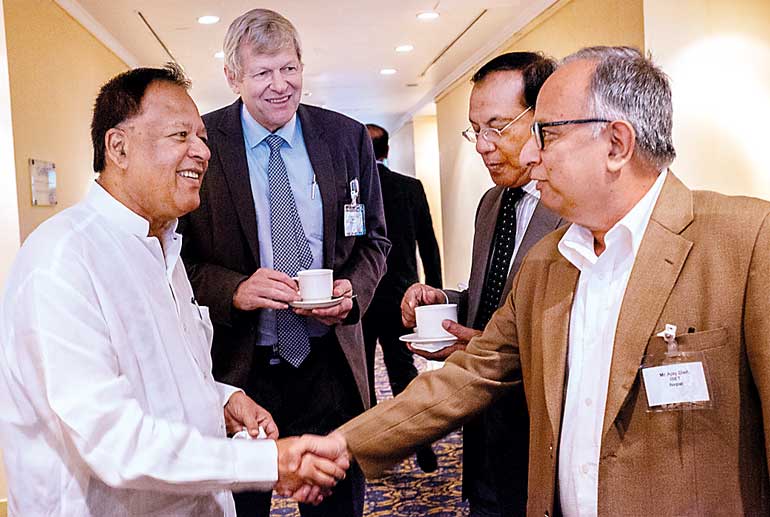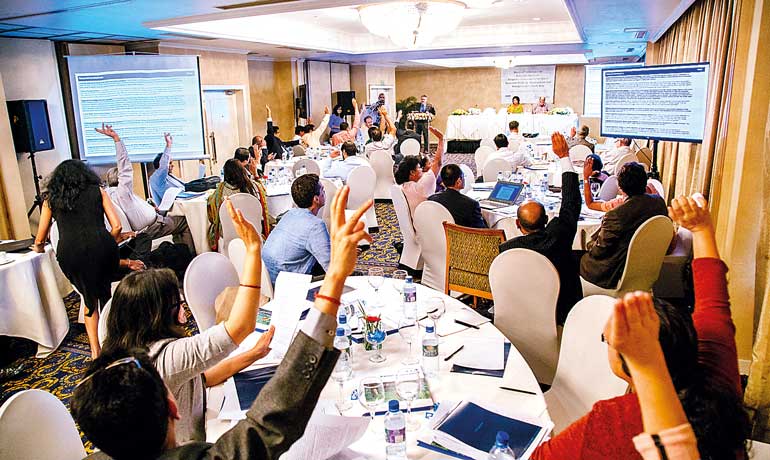Thursday Apr 25, 2024
Thursday Apr 25, 2024
Wednesday, 20 July 2016 00:00 - - {{hitsCtrl.values.hits}}

From left: Rolande Price (World Bank), Jeremy Bird (IWMI), Minister for Special Assignments Sarath Amunugama, Prof. M. Munasinghe (MIND), Dr. Rafik Hirji (World Bank), Dr. Alan Nicol (IWMI) – Photo credit Shaoyu Liu

Field trip – IWMI’s Sanjiv de Silva and the Sri Lanka Department of Irrigation members show participants irrigation and flood control procedures around Kelani River – Photo credit Shaoyu Liu

Tea break – Minister for Special Assignments Sarath Amunugama and IWMI Director General Jeremy Bird greet Executive Director Ajayi Dixit from ISET Nepal – Photo credit Shaoyu Liu

Voting on next steps – the conference ends with an informal vote on eight potential recommendations to move forward water management across South Asia – Photo credit Shaoyu Liu
An international conference on climate change and water resources management has concluded that urgent action is needed to ensure South Asia is better prepared to address future climate conditions, including anticipated extremes of flooding and drought.
Part of the World Bank-led South Asia Water Initiative (SAWI), the conference saw participation from over 65 water resource and climate change experts, scientists and policy makers from seven South Asian countries- Afghanistan, Bangladesh, Bhutan, India, Nepal, Pakistan and Sri Lanka – as well as China.
Speaking at the opening session, Guest of Honour Minister for Special Assignments Dr. Sarath Amunugama said: “This seminar comes at a very important time, almost all countries represented here face crises of some sort as a consequences of climate change.”
According to research undertaken by IWMI scientists, many areas of Sri Lanka will experience future changes in temperature, rainfall, evaporation and sea level rise. This will affect a range of sectors, including agricultural production of important export crops. Surface and groundwater quality in coastal areas is also likely to be impacted affecting important drinking water supplies. Participants agreed that coordinated responses across all sectors can help to reduce the impacts of changing weather patterns on key sectors, urban centres and the country’s substantial natural heritage.
Three scientific papers presented at the conference highlighted the pressing need for action amid the uncertainty surrounding future water access and availability. The primary climate change effects on water resources include increased temperatures, changes in annual rainfall, changes in monsoon seasonality, increased variability and sea level rise.
These in turn will result in secondary effects: increased evapotranspiration, changes in river flows, groundwater recharge, snow and glacial melt. Saltwater intrusion in coastal aquifers and estuaries is also expected, and there is likely to be increased risk of extreme events such as floods (regional and local flooding and glacier lake outburst), droughts and storms.
Underscoring the need for solutions that can adapt to change and are therefore more responsive to uncertain decision-making environments, Professor Casey Brown from the University of Massachusetts Amherst presented the decision tree framework supported by the World Bank. This framework informs planning of water resources infrastructure using examples from hydropower planning in Nepal and water supply planning in Kenya.
Professor Aris Georgakakos from Georgia Water Resources Institute presented an integrated river basin planning approach used for the Rufiji basin in Tanzania under the World Bank Water Sector Support Project which emphasised smart approaches to develop “no regrets” solutions benefiting communities, agriculture and energy sectors, business and the natural environment, as well as integrating climate change implications.
Other notable experts included Professor Mohan Munasinghe, one of Sri Lanka’s most senior researchers on climate change and a member of the UN’s Intergovernmental Panel on Climate Change. Highlighting the vulnerability of South Asia to climatic fluctuations, he stressed the importance of managing water resources in a manner consistent with the Sustainable Development Goals, suggesting the need for a Sustainable Water Resources Management approach, ‘SWARM’.
Climate change is likely to profoundly impact water supply and demand as well as increase extreme events, such as floods and droughts, underscoring the need for developing effective policy frameworks as well as practical adaptation responses.
According to Dr. Rafik Hirji, the World Bank Team leader, “Governments in the region who haven’t yet mandated integrated water resources management (IWRM) are urged to step up efforts to formulate and implement those policies and those with policies in place need to elevate attention to their implementation. Effective planning, development and management of surface and groundwater will be key to ensuring that the resource is protected, conserved, secured and utilised optimally for the benefit of all South Asians.”
The conference recommended an adaptation framework for water resources planning, development and management that centres around five key dimensions:
nimproving water resources and climate data and information;
nstrengthening water resources governance instruments (policies, laws, institutions);
nbuilding climate resilient infrastructure;
npromoting systematic planning and management of surface and groundwater; and
ndeveloping targeted communication and education about water-related climate change risks and solutions, and enhancing participation of communities at all levels of decision making.
Concluding the conference, Dr. Alan Nicol, Theme Leader Governance, Gender and Poverty at IWMI, said: “This meeting has shown a remarkable level of regional collaboration and information sharing. We now need to take this forward with the support of all stakeholders to ensure future robustness to climate change through effective water resources management.”
Experts voted on series of potential next steps including practical initiatives on public education and awareness raising, initiatives on flood early warning and on climate adaptation and groundwater, ways of addressing ‘non-water’ sectors effectively in tackling water governance challenges and building more substantial regional data and knowledge sharing and capacity building through establishing a community of practice.
The conference was followed by a field visit on 14 July organised by the Ministry of Irrigation and Water Resources Management to areas north of Colombo recently affected by flooding along the Kelani River, and where flood response measures are being undertaken by the Government.
For presentations and papers, go to conference web link http://goo.gl/YuJuYO.
The International Water Management Institute (IWMI) is a non-profit, scientific research organisation, headquartered in Colombo, which focuses on the sustainable use of water and land resources in developing countries. IWMI is a member of the CGIAR Consortium.
CGIAR is a global partnership that unites organisations engaged in research for a food-secure future. It leads the CGIAR Research Program on Water, Land and Ecosystems which examines how we can intensify agriculture while still protecting the environment and lifting millions of farm families out of poverty. www.iwmi.org
The World Bank Group headquartered in Washington, DC with Country Offices in South Asia, including Sri Lanka is committed to achieving a water secure world for all by helping countries manage water sustainably across multiple sectors, now and for future generations.
It is a major water sector development partner in South Asia. The bank’s lending portfolio in SAR includes 172 projects totalling $ 25 billion in the Water Practice and an additional $ 10 billion of water-related lending in other practices). Of this, 28% is in SAR, and this proportion is growing.
Within the water portfolio, work on water resources management is now the largest and fastest growing component. This increasingly includes supporting water supply and water resources infrastructure, governance and institutional reforms, and improved water planning for river basins and aquifers and climate change adaptation.